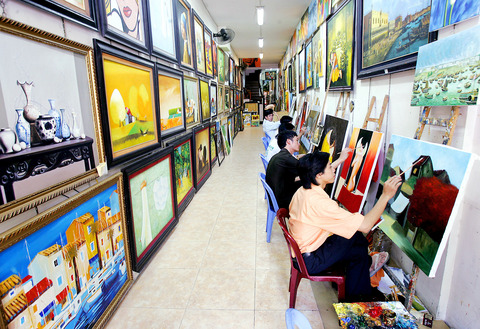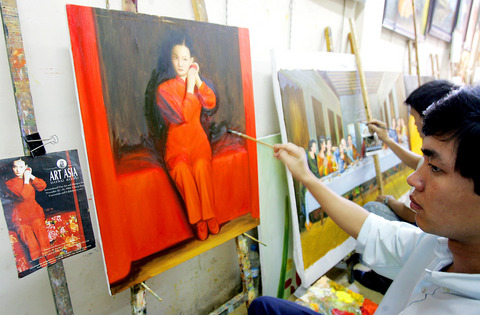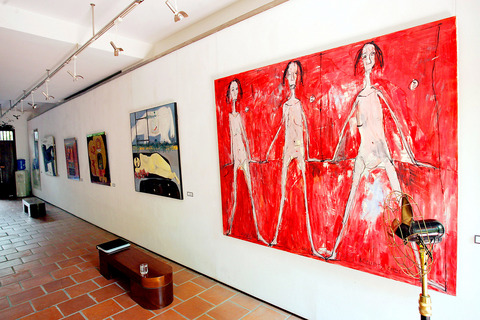A decade after modern Vietnamese painting made a splash on the world scene, critics and galleries say rampant commercialization and a glut of cheap copies are threatening the young art movement.
The original works of Vietnam's best-known artists are fetching small fortunes in Hanoi, Hong Kong and Singapore. But for each authentic work, hundreds of reproductions are being churned out by craftsmen who have almost perfected a tradition of faithfully copying their masters.
Some of Vietnam's top artists themselves have added to the problem by mass-producing works that originally won them critical acclaim, leading to a creative stagnation and drop in art prices, say some galleries.

PHOTOS: AFP
“Many painters turned to the commercial production of their work solely for the marketplace and managed to make a good living doing this,” says Suzanne Lecht, director at Art Vietnam, one of the main galleries in Hanoi.
“Sometimes the influence of money weighs more heavily than the desire to produce a singular work of art.”
Vietnamese visual art, influenced by ancient Chinese and modern French styles, awoke in the 1990s from a long slumber during which the communist regime allowed only socialist realism, art for political purposes.

As Vietnam's doi moi (renewal) reforms kicked in and the country reopened its doors to the outside world, a wave of painters emerged to the delight of art lovers who hailed the works as both fresh and uniquely Vietnamese.
The vibrant and abstract landscapes of Le Thiet Cuong, Thanh Bien's dreamlike depictions of women in traditional ao dai dresses, and the Cubist-influenced lacquer works of Thanh Chuong all earned praise from foreign collectors.
In 1995, a canvas by Do Quang Em sold for more than US$50,000 at Hong Kong's Galerie La Vong, one of a number of galleries devoted to Vietnamese art that sprang up around the Asian region.

The commercial success of Em, whose naturalistic still-lives are said to recall the old Dutch masters, was the spark that led collectors and critics to take the movement seriously, say some experts.
It showed that “Vietnamese art is unique and different from that of other Asian countries,” says Shirley Hui of Galerie La Vong. “It combines local culture and traditions, the French legacy and ancient Chinese philosophy.”
Many Vietnamese artists have continued to explore new creative avenues, dabbling in new styles, motifs and media — but for others the overnight success has amounted to a creative kiss of death, say critics.
“We have some great artists who are doing well and don't produce too much,” says Hui. “But a number of others become commercial and then just keep copying their own work. They will ruin their future in the market.”
New generation
Today the tourist areas of Hanoi and Ho Chi Minh City abound with hundreds of galleries that mostly specialize in detailed reproductions of famous Western artists, from Leonardo da Vinci to Vincent Van Gogh to Andy Warhol.
Equally popular, and some say equally kitsch, are the Vietnamese paintings that depict a romanticized vision of a land of lotus flowers, conical hats and flooded rice paddies, of water buffalo and colorful ethnic minority markets.
Some top-end galleries sell original masters, typically for US$3,000 to US$5,000 apiece — but for each original artwork, a gallery down the street will likely sell a cheap imitation, leaving many potential buyers baffled.
For those not intimately familiar with what's real and what's not, the Vietnamese art market can be a minefield.
“Many people are frightened of buying without being sure that it is an original,” says Art Vietnam's Lecht. “There is no governmental body that can provide a certificate of authenticity.”
Despite the plagiarism and the heavy hand of state censorship — Vietnamese artists still need state permits to mount exhibitions — not all is gloomy.
A new generation of more edgy artists is emerging in Hanoi, and increasingly in the bustling southern commercial hub of Ho Chi Minh City, eager to adapt their styles to depict the rapidly changing society around them.
The surrealist works of one rising star, Hanoi's Nguyen Manh Hung, touch on the country's bloody history without being overtly political, using images such as military jets pulling carts filled with rice stalks.
Another newcomer creating a buzz is 32-year-old painter and video artist Hoang Duong Cam, whose bold and vibrant exhibition Filename.disan (heritage) has been shown at Ho Chi Minh City's avant-garde Galerie Quynh.
Described as a comment on technology and culture, and the blurring of East and West, the abstract works mix traditional and modern images, such as the ao dai girl and modern bras, under layers of bold color.
“When I was at university, we were supposed to paint buffalo, ethnic minority people and ao dai girls to get high marks,” says Cam. “As for art movements, we were taught only French impressionism and socialist realism.
“My generation had little access to information for a long time. Now young artists look on the Internet or ask foreign friends to send art magazines to discover what is happening abroad.”
In his works, Cam explains, he tries to depict “the Vietnam of today — between tradition and consumer society”.
Cam, who previously made ends meet as a graphic designer, says proudly, “I am at last a full-time artist.
But he has sympathy for those who primarily paint to pay the bills. “There are many who have to earn their living another way.”

May 11 to May 18 The original Taichung Railway Station was long thought to have been completely razed. Opening on May 15, 1905, the one-story wooden structure soon outgrew its purpose and was replaced in 1917 by a grandiose, Western-style station. During construction on the third-generation station in 2017, workers discovered the service pit for the original station’s locomotive depot. A year later, a small wooden building on site was determined by historians to be the first stationmaster’s office, built around 1908. With these findings, the Taichung Railway Station Cultural Park now boasts that it has

The latest Formosa poll released at the end of last month shows confidence in President William Lai (賴清德) plunged 8.1 percent, while satisfaction with the Lai administration fared worse with a drop of 8.5 percent. Those lacking confidence in Lai jumped by 6 percent and dissatisfaction in his administration spiked up 6.7 percent. Confidence in Lai is still strong at 48.6 percent, compared to 43 percent lacking confidence — but this is his worst result overall since he took office. For the first time, dissatisfaction with his administration surpassed satisfaction, 47.3 to 47.1 percent. Though statistically a tie, for most

Six weeks before I embarked on a research mission in Kyoto, I was sitting alone at a bar counter in Melbourne. Next to me, a woman was bragging loudly to a friend: She, too, was heading to Kyoto, I quickly discerned. Except her trip was in four months. And she’d just pulled an all-nighter booking restaurant reservations. As I snooped on the conversation, I broke out in a sweat, panicking because I’d yet to secure a single table. Then I remembered: Eating well in Japan is absolutely not something to lose sleep over. It’s true that the best-known institutions book up faster

In February of this year the Taipei Times reported on the visit of Lienchiang County Commissioner Wang Chung-ming (王忠銘) of the Chinese Nationalist Party (KMT) and a delegation to a lantern festival in Fuzhou’s Mawei District in Fujian Province. “Today, Mawei and Matsu jointly marked the lantern festival,” Wang was quoted as saying, adding that both sides “being of one people,” is a cause for joy. Wang was passing around a common claim of officials of the People’s Republic of China (PRC) and the PRC’s allies and supporters in Taiwan — KMT and the Taiwan People’s Party — and elsewhere: Taiwan and